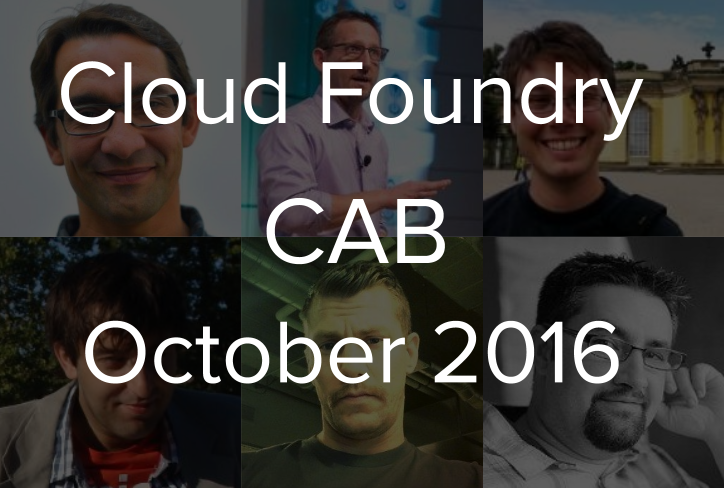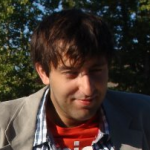Cloud Foundry Advisory Board Meeting, Oct 2016: Cultivating Non-Core Projects

Reflecting the presence of notable Cloud Foundry-based projects conducted outside of the core product development team, the October Community Advisory Board (CAB) call took a different direction from past calls by highlighting some of them.
An initial group was outlined by Chip Childers, VP Technology at the Cloud Foundry Foundation (CFF). Similar discussions may take future calls in a direction that emphasizes such projects.
This month’s call also featured numerous technical reports and some discussion on specific technical topics. A recap of the recent Cloud Foundry Summit Europe and a preview of the Cloud Foundry Days coming up throughout Asia Pacific were also presented.
Out in the great wide open
The idea of featuring non-core projects began with some recent commentary on the Cloud Foundry Slack channel by the CFF CEO Sam Ramji.
“Where do we have conversations about innovation on and around Cloud Foundry,” he asked. “(The community has) a rich repository and an abundance of new ideas for projects and extensions, which in most open-source communities would be welcomed and perhaps curated.”
He cited an idea from a prominent Cloud Foundry community member Jared Wray to develop a “Build Foundry” for the purpose of “making our community more self-governing and making the core project more useful by borrowing the NPM concept from Node.js and applying it to buildpacks,” Sam wrote. “Why do we have just six core buildpacks (for example), and where do you find others? Given the proliferation of languages and frameworks, why don’t we have hundreds of buildpacks with a few dozen very popular and well-reviewed ones?”
“Where do we have conversations about innovation?” —Sam Ramji, the Cloud Foundry Foundation
Following this line of thought, Sam also wrote, “What if the CAB were actually empowered in a way to curate Cloud Foundry community? What if this related in some thoughtful way to inceptions/proposals? What if it were a way to anoint really compelling community projects that don’t need to be in the upstream (and therefore in the certified core)?”
And here are some examples
During the actual CAB call, Chip referred to several ongoing projects being undertaken outside the core open-source Cloud Foundry project:
Service Fabrik, a project from SAP to develop a service broker that provisions Docker containers and BOSH deployments within the Cloud Foundry ecosystem. It also serves as a framework for dynamic provisioning for back-end databases.
Open-Control.org, a project derived from work by 18F for the federal government. It documents how apps have controls to support requirements in a continuous delivery way. Chip noted that it would be cool to see people from non-government sectors to get involved in this project.
Dingo Tiles, a service broker component for Dingo PostgreSQL, building on current work at Stark & Wayne.
Deis Project, a Kubernetes-native service broker.
Dozer, a GUI for BOSH. Members of this initiative were giving demos in Frankfurt.
One can see there is a panoply—perhaps a plethora—of possibilities within the global Cloud Foundry community. Discussion during the call covered the idea of inviting one or two leaders of such projects to present at future CAB calls.
Technical notes, as well
A few technical notes were also presented during the call.
Pivotal’s Nick Calugar from the CAPI team mentioned a new cut that contains a large migration to make all V2 apps available as V3 apps. “The V3 API is still experimental, but this is a big step,” he said. “You can push V2 apps as you normally do but run them as V3. We’re also working with the CLI team in building up commands to take advantage of all V3 features.”
“The V3 API is still experimental, but this is a big step.” —Nick Calugar, Pivotal
Pivotal’s Eric Malm from the Diego team said they’re continuing scaling tests. “We delivered our last stories on a 50K-instance test run,” he said. “We’re now getting ready to run 250K [containers].”
IBM’s Julian Friedman (Dr. Julz) from the Garden team recapped the talk he gave in Frankfurt about using an OCI image format, so that staging a buildpack would result in a registry. “Instead of a droplet sort of TAR that you have to move around, you get a proper first-class image, and that image would be (in) an OCT image spec,” he said. Noting that this idea may generate some controversy, he asked for input to know if he and the team should prioritize it or not.
Many more details about this effort can be found in his Frankfurt talk.
Pivotal’s David Morhovich talked a bit about the Steeltoe OSS project for cloud-native .NET applications. He analogized it as .NET of Spring Cloud, noting it enables developers to build microservices to operationalize them, “taking service-level things and building .NET clients.”
The shows must go on
The Frankfurt summit was held September 26–28, and had more than 700 registrants, with two-thirds of them having already adopted Cloud Foundry in one form or another. Chip reported there were 160 companies and 32 countries represented.
The presentation videos have already been published for anyone who wishes to view them.
Meanwhile, several Cloud Foundry Days are set to begin in Asia Pacific. These events are each sponsored by one or two key technology companies and will launch in Sydney (October 18) and Melbourne (October 20), before continuing onto Shanghai (October 25), Tokyo (November 11), Singapore (November 15), and Hong Kong (November 17).
The next CAB call is set for Wednesday, November 9, at 8 a.m. Pacific Time. Anyone interested is free to join the call and its corresponding Slack channel.












